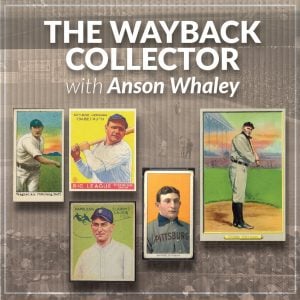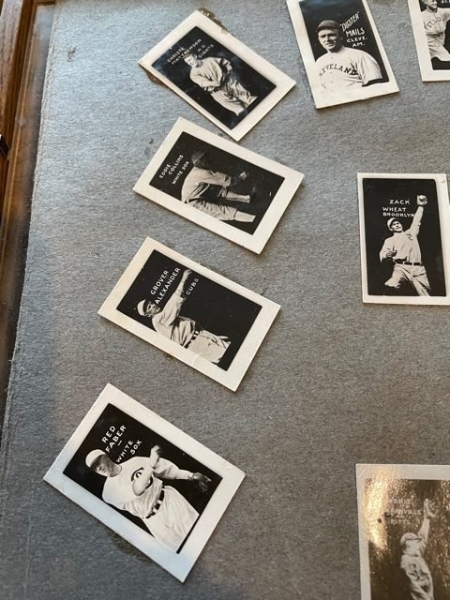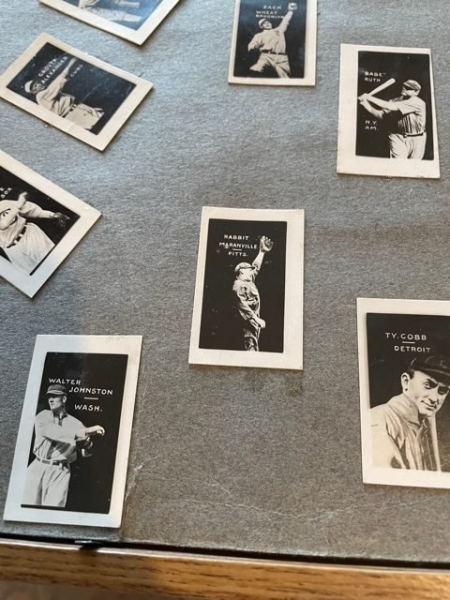Near Set of Rare 1921 Self Developing Strip Cards Discovered

Contents
Little is known about the unclassified baseball card set dubbed as 1921 Self Developing Strip Cards. But a new discovery of them will certainly reignite some interest in learning more about this interesting set.
Calling them strip cards is even a bit misleading. In reality, these are small cards with real pictures of players. However, that is their designation in one of the only publications to reference them — The Standard Catalog of Vintage Baseball Cards.
That book calls them self-developing cards — cards that could be created through the use of a negative of a real picture or by exposing the cards to sunlight. However, collectors even question if that is what they are as the images are much crisper than ones that are found on other types of self-developing cards, such as the more popular 1948 Topps Magic set.
In short, exactly what these cards are has remained a mystery for a long time.
A Rare Find
A woman requesting anonymity is in the process of selling her aunt’s home on the coast of Washington state. According to her, an uncle that would have turned 90 this year kept quite a few things.
“(He) was one that collected everything,” she recounted to me in a recent phone call. The woman also mentioned that his mother was a collector of all sorts of things as well. Now, the uncle did not appear to specialize in baseball cards. Rather, his collection was merely an assortment of, for the lack of a better word, stuff.

The house, she explained, includes all sorts of collectibles, ranging from photographs of silent movie actors and actresses to a picture of Babe Ruth to — the baseball cards.
The cards owned by the woman’s aunt and uncle weren’t something that were known. In fact, they were hidden away in the house and only discovered by chance.
“We moved a gun case,” she explained, “and behind the gun case were these cards.”
Appearing to be lightly affixed to a felt backing, the display included some of the rarest baseball cards known to anyone — a near complete set of the very rare 1921 Self Developing Strip Cards.
Just how rare are these cards? A total of 16 cards had been known in the set’s checklist and even those were hardly ever seen. 14 were in the Standard Catalog checklist and two others, Christy Mathewson and Ed Murphy, have been auctioned and known to exist as well. This collection discovered here includes 12 of those 16 cards — as well as six new others believed to be completely new to the hobby checklist.


The collection has all four of the real heavy hitters, including Babe Ruth, Ty Cobb, Walter Johnson, and Mathewson. However, all of the other known Hall of Famers in the set, including Grover Alexander, Eddie Collins, Red Faber, and Rogers Hornsby, are there, too.
That would be impressive enough, of course. However, the previously unknown cards take this collection to another level.
While none of the unknown cards threaten the popularity of Ruth and Cobb, the fact that they have not resided in the checklist already means they are important finds.
New additions to the checklist include Bobby Roth (of which there are two) and Duster Mails. But the new finds also include four Hall of Famers, including Zack Wheat, George Sisler, Rabbit Maranville, and George Kelly.
1921 Or …
The date on the set is checklisted as 1921. That date could have been chosen because of two players in the known checklist — Wally Schang and Bill Killifer. Why those two players?
Killifer is pictured as a member of the Chicago Cubs and he played with that team from 1918 through 1921. Schang is shown as a Yankee and his years with that club spanned from 1921 through 1925. 1921 is the only year that those two players match up simultaneously with those teams. Thus, it is easy to arrive to the 1921 date.
However, not everything aligns with that year. Bobby Roth, for example, is shown with the Cleveland Indians. The problem is that he was only with that team from 1915 through 1918. 1921, his final year in the majors, was actually spent with the Yankees. Roth is one of the previously unchecklisted cards and may caused those that dated it as 1921 to pause.

The card of Mathewson is less problematic but still a bit of a head-scratcher since he had played his last major game back in 1916. Some of the players had not even played for their pictured teams yet when Matty was still an active player, so we know that it could not have been printed during his playing days.
Is there any way to explain those two conflicts with the 1921 date?
Well, in the case of Mathewson, sure. He was a popular player and many players found themselves in baseball card sets after their careers had ended.

The case of Roth is a little harder to reconcile to the 1921 date. However, his career as a journeyman bouncing around may have had something to do with the issuers of the set printing him as a member of the Indians. Roth spent eight years in the major leagues but never stuck with any team for even two years — except for the Indians. He played 415 games with Cleveland and not even 1/3 of that with anyone else. In fact, Roth didn’t even play 415 games for all of his other teams combined.
It is possible, too, that the set was printed over the course of more than one season. That, of course, happened with other sets of baseball cards in the pre-war era.
Were the cards truly issued in 1921? That is tough to say definitively. Just one more mystery to chew on with this set. Regardless of their exact date of production, though, it can be said that this was one terrific find.
What are the cards worth? That’s impossible to say, really, given how little they are publicly bought and sold. Brockelman Auctions sold a very low-grade SGC 1 of Alexander in 2013 for $330. In 2016, Heritage sold a Mathewson SGC 1.5 for $717. That might seem to provide a baseline, but not really.
Both of those cards were very low-grade compared to the eye appeal offered in these cards. Additionally, the sales are quite old and prices for baseball cards have been skyrocketing. Determining value with rare cards is often difficult because they are not bought and sold often. Such is the case with these cards — some of which are not even known to have ever been publicly offered.





